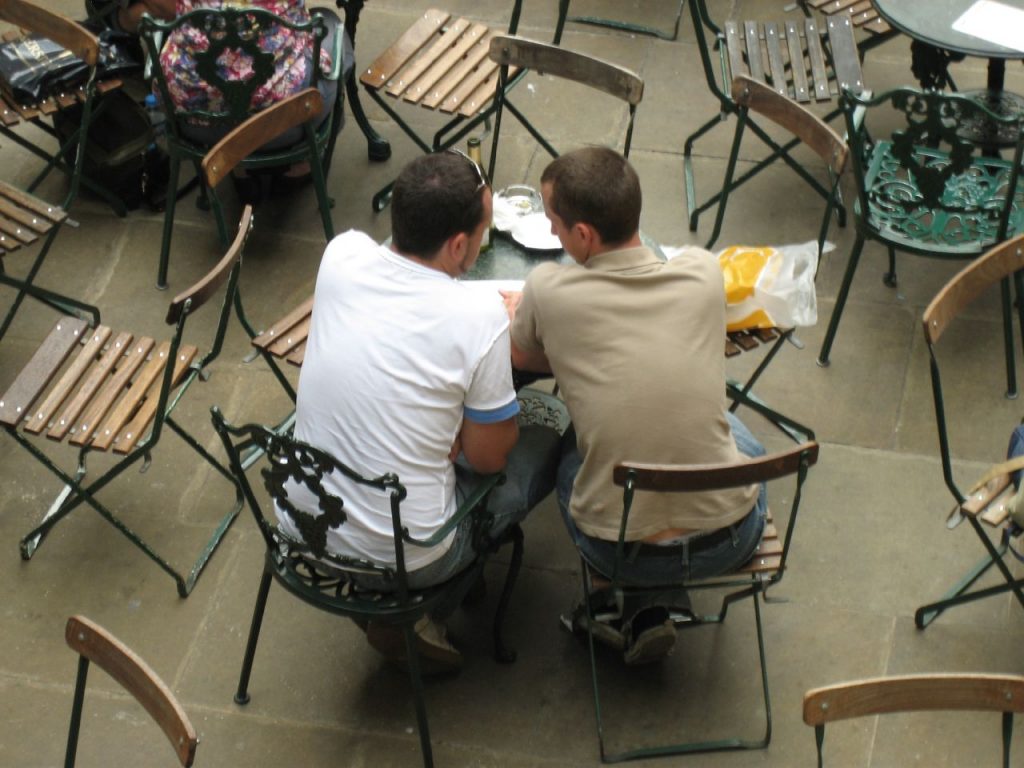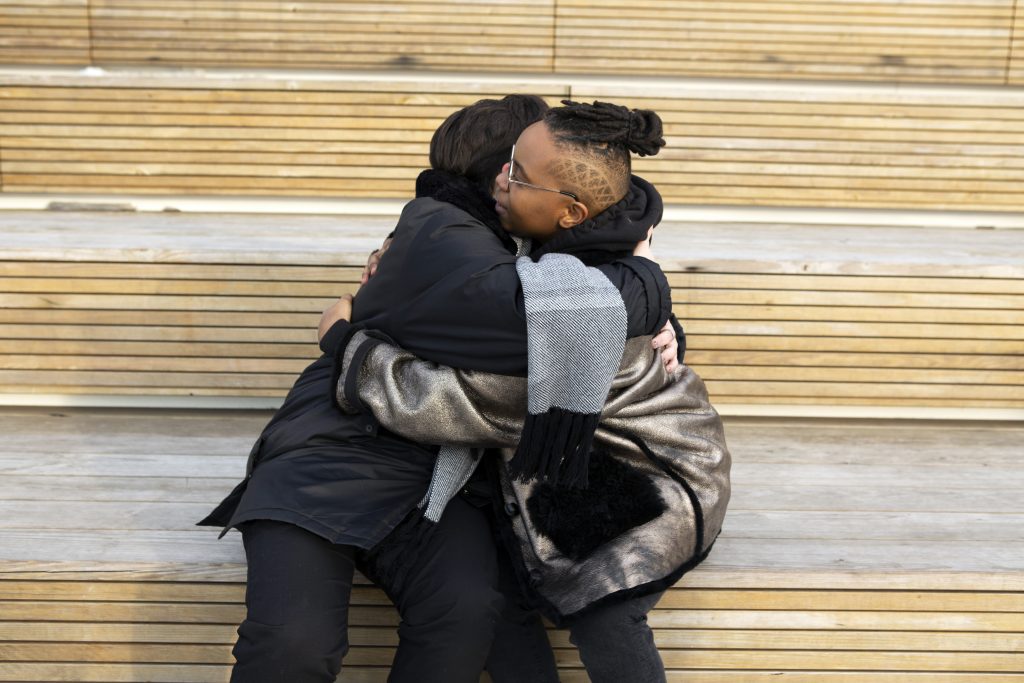Love and Union Formation
Elizabeth B. Pearce
Love and Union Formation
“Being deeply loved by someone gives you strength, while loving someone deeply gives you courage.”
–Lao Tzu, Philosopher
Relationships represent the excitement, passion, security, and connection we experience; they also represent the sadness, heartbreak, insecurities, violence, and loneliness we find at times.
Close relationships, such as those with a confidant or spouse, are highly associated with health and recovery from disease. In studies of various forms of cancer, including breast cancer, having one or more confidants decreased the likelihood and frequency of relapse.[1] As a social species, intimate relationships are a fundamental aspect of our life.
- Fig. 5.3. Talking.
- Fig. 5.4. Walking.
- Fig. 5.5. Hugging.
Theories of Love
Love is a multidimensional concept and psychologists and sociologists have defined it in a variety of ways over the years. Here we look at two frameworks that describe varying kinds of love within intimate relationships.
Lee’s Theory of Love
John Lee was a well-known Canadian psychologist who has a theory on love including six love types. Lee assumed that we all shared six core components of love and that our current loving relationship can be assessed and measured. Lee also claimed that there are qualities of love types—some more long-lasting and supportive of relationships and some pathological and defective which inhibit relationships. Lee’s love types are widely used to help people understand their love styles. Lee claimed that six types of love comprised our loving experiences.
Eros
Eros is the love of sensuality: sex, taste, touch, sight, hearing, and smell. Eros love is often what we feel when turned on. Eros love is neither good nor bad; it is simply part of the overall love composite we experience with another person.
Storgé
Storgé is the love of your best friend in a normal casual context of life. Storgé is calm and peaceful, surprising to some who might have simply hung out together at one point but suddenly discovered that their friendship deepened and became more important than other friendships. “We started needing to be together, talking on the phone for hours, and missing each other when apart,” are common descriptions of Storgé love.
Pragma
Pragma is the love of details and qualities in the other person. Pragma lovers are satisfied and attracted by the other because of their characteristics (e.g., athleticism, intelligence, wealth). Pragma lovers feel love at a rational level—thinking to a certain degree about the good deal.
Agapé
Agapé is the love that is selfless, other-focused, and seeks to serve others rather than receive from others. In Christian theology it’s the love of God for mankind.
Ludis
Ludis is an immature love that is more of a tease than a legitimate loving relationship.
Ludic lovers trick their mates into believing that they are sincerely in love, while grooming 1, 2, or even 3 other lovers at the same time. Ludic lovers typically artificially stroke their sense of self-worth by playing a cruel game on their lovers who end up feeling used and betrayed.
Mania
Mania is an insecure love that is a mixture of conflict and artificially romantic Eros expressions. Manic lovers fear abandonment and are simultaneously terrified by the vulnerabilities they feel when intimate with their lover. Thus, their daily routines typically involve extreme highs and lows including arguing, making love, sweet-talking, and fighting with their lovers.

Robert Sternberg’s Triangular Theory of Love
Robert Sternberg was the “Geometry of Love” psychologist who triangulated love using intimacy, passion, and commitment by measuring the intensity of each and how intense the triangulation was for the couple. To Sternberg it was important to consider how each partner’s triangle matched the other partner’s. He said that a couple with all three types of love balanced, and in sufficient magnitude, would have a rare yet rewarding type of love that encompassed much of what couples seek in a loving relationship. Sternberg’s consummate love is a love type that had equal measures of passion, intimacy, and commitment that is satisfactory to both lovers.
In modern day applications of love, various components have been found as the ingredients of love: commitment, passion, friendship, trust, loyalty, affections, intimacy, acceptance, caring, concern, care, selflessness, infatuation, and romance. There is a love type identified that many people are aware of called unconditional love. Unconditional love is the sincere love that does not vary regardless of the actions of the person who is loved. You often hear it expressed in greater measure among parents of children whose misbehaviors embarrass or disappoint them. The love types and patterns discussed below are taken from many sources, but fit neatly into the Lee, Maslow, Sternberg, or Chapman paradigms.
Romance
Romantic love is based on continual courtship and physical intimacy. Romantic lovers continue to date long after they marry or move in together. They often express the strong sexual attraction to each other that was there from the beginning. Romantic lovers are idealistic about their relationship and often feel that it was destined to be. They often define mundane activities such as grocery shopping or commuting to work as escapades of two lovers.
Infatuation
What happens when very young people feel love for the first time? What is puppy love or infatuation? Infatuation is a temporary state of love where the other person is overly idolized and seen in narrow and extremely positive terms. An infatuated person might think obsessively about the other, may feel a strong emotional response when they are together, may see their entire world as revolving around the other, may see them being together for the rest of their lives, may find one or two qualities of the other as being near perfect, or may be seen by others as having a crush on the other person. Regardless of the details infatuations rarely last very long. This love develops quickly much like a firework launches quickly into the night sky, puts on an emotional light show, then burns out quickly. Many define puppy love or infatuation as an immature love experienced by those who are younger and perhaps a bit credulous.
Commitment
Committed love is a love that is loyal and devoted. Two lovers may share committed love with or without: physical affection, romance, friendship, trust, loyalty, acceptance, caring, concern, care, selflessness, and or infatuation. Committed lovers have a long-term history with one another and typically combine care-giving, concern for one another’s well-being, and spending much time thinking of the other. Committed lovers are there when needed by the other person.
Altruism
Altruism is a selfless type of love that serves others while not serving the one who is altruistic. True altruism is hard to find, according to some. Mothers who tend their sick child throughout the night; fathers who work 3-4 decades in a job they don’t love to provide for their family; and even firefighters who sacrifice their safety to save the lives of others are all considered to be altruistic in their actions. Because so much of what we do in our relationships is considered in the larger overall equation of the fairness in a relationship, selfless acts can be seen as acts which either build a reservoir of goodwill which will later be repaid or creating a debt of sorts in which the other person owes you some selfless service in return.
Passion
Sexual or passionate lovers are focused on the intensely sensual pleasures that are found with the senses of taste, smell, touch, feel, hear, and sight. Sexual lovers lust one another and feel closest when together and being physical. Sexual lovers can be together for five minutes, five days, five weeks, or five years, but sexual love, by itself is typically short-lived. There is closeness during sex and activities leading up to sex, but not much thereafter. Sexual love when combined with other love types can be very beneficial to the couple. Sexual love is almost always the love type experienced by those having an extra-marital affair.
Friendship
Friendship love includes intimacy and trust among close friends. Today, most long-burning or enduring love types form among people who were first close friends. Friendship lovers tend to enjoy each other’s company, conversation, and daily interactions. They consider one another to be “go-to” friends when advice is needed or when problems need to be talked about together. Not all friendship lovers become a couple. Many are just close or best friends. Yet many who spend the rest of their lives together will start out their relationship as friends.
Realistic Love
Criteria or realistic love is the love feelings you have when your list of a potential mate’s personal traits is met in the other person. For example, women often desire their male love companions to be taller. People often desire to find a partner with assortative traits (e.g., same religion, political leanings, hobbies, etc.).
Obsession
Obsessive love is an unhealthy love type where conflict and dramatic extremes in the relationship are both the goal and the theme of the couple’s love. Obsessive lovers live for storms and find peace while they rage. They are often violent or overly aggressive at different levels. Sometimes couples bring complimentary traits to the relationship which light the other’s fire of madness. In other words, she may be angry and violent with him, but not with some other males. He may feel simultaneously drawn to her and repulsed, but not with other females. Their personality-chemistry contributes to the insanity and lack of peace. These couples most likely need professional counseling and would probably be better off if they broke up. At the same time, why would they seek help or leave the person whose entanglements bring them such an occupation with drama and conflict that they are freed from their boredom and entertained at the same time?
Influences on Union Formations
The factors related to the selection of the people that we are emotionally and/or physically intimate with are complex and nuanced. The spirit of this textbook is to aspire to discuss this topic in a way that recognizes the diversity of family formations in the United States. Here we will do our best to identify some of the shared factors that affect human beings who choose a mate for a long-term relationship.
In order to organize our own thinking we name and label things to better understand the world around us. As our society changes and expands, descriptions and labels come more slowly, creating cultural lag and causing disconnection. For example, marriage was once defined between only a man and a woman. It is now recognized legally that this is a limiting description that is not representative of our nation’s unions. In addition, couples have formed via common-law marriage and/or cohabitation throughout our country’s history. We will use the terms “partnerships, relationships, and union formations” to include all couple relationships, including marriage. When specific research has focused only on married relationships rather than the broader spectrum, we will use the term “marriage.” Within our text, we acknowledge and celebrate all marriages/unions/partnerships/relationships that may have mixed legal, religious, or community acceptance.
Here we will explore the ways that kinship groups and society influence our selection of a primary mate or mates. In addition, we will review the Social Exchange Theory.
- Fig.5.7. Polyamory is an expression of love among multiple intimate partners.
- Fig. 5.8. Romantic couple.
Family Experiences, Values, and Expectations
How we choose the people we connect with is influenced by our family experiences, values, and expectations. It is common for adults to communicate and mold these with their young children. For example, a parent makes a light-hearted comment about their three-year-old having a boyfriend or girlfriend. And in another comment about marriage, assumes that that child will marry, and that it will be to a person of the opposite gender in a binary system. Within the rules and structure of our family of origin, children navigate crucial social experiences that will affect mate selection and relationship dynamics. Young children are most influenced by the world that is both tangible and current. Socialization theory suggests that many of our ideas about gender-based behaviors are formed for life during our early childhood years. Our family of origin impacts how we orient to particular family themes, identity images, and myths that further delineate and define who is an appropriate intimate partner for us.[2]
Assortative Mating
When you consider your current mate, or any intimate partners that you seek, are they more like you or quite different from you? The idea of assortative mating, simply put, is that human beings tend to choose intimate mates who are more like themselves than if mates were assigned randomly. (As it turns out, non-human animals do as well, but that’s another story).
The ways in which we might choose partners assortatively are quite wide and varied, but can be divided very loosely into two categories: the physical and the social. Height and appearance both fit into the physical category; in this text we will focus more on the social categories which include culture, ethnicity, religion, education, and socioeconomic status.[3] In particular, education level has become an increasingly assortative factor within union formations in the United States. Between the 1940’s and the 1980’s education increased as an assortative factor until it leveled off for those with higher education degrees. It continues to increase for those without a high school degree, however.[4] While the patterns in assortative and disassortative relationships have been studied, it is challenging to determine the underlying reasons for this behavior.
Because income level is increasingly associated with higher education, this pattern interacts with the trends in socioeconomic status in this country and may contribute to the cycle of poverty. It is important to note that this change affects the current generations in ways that we don’t yet completely understand. Millennials (or Gen Y) and Gen Z (or iGen) are coping with the increased importance of education to income and status at the same time that college costs and student debt have increased dramatically. How this affects union formation and other family patterns remains to be seen. Based on what is known about couples wanting to be financially stable before marrying, it is likely that the trend of marrying less and marrying later will continue.
The Evolving Economy and Social Movements
Economics and social change affect personal choices about unions, but they also influence the way the role of mate, partner, or spouse is defined. In the early days of this country, and indeed before the formation of the United States, both Native families and Euro-American settlers relied on their kinship and family groupings for survival. Native families lived in tribes that shared spiritual beliefs and resources. Extended kin networks were, and still are, critical to the stability of the community.[5] Euro-American families were large, with an emphasis on mate selection that would ensure as much financial stability and likelihood of survival. Fertility was valued because children were seen as assets in the shared family work. Love as a rationale for marriage was disdained; feelings might change and a marriage built on instability could threaten survival.[6]

As the country industrialized, roles became more gender specific: men tended to work in the factories and women more likely managed the home and children. This is known as the development of separate spheres, an idea that has persisted, though weakened, into the 21st century.[7] A growing economy and more routinized family patterns contributed to stability and a decreased focus on survival. It was still important to consider economics in a partnership, but romance, sexual companionship, and love also became expectations of intimate and marriage relationships. Family size decreased dramatically as both child mortality decreased and the White middle class evolved. Children and women in minoritized groups continued to contribute to the family income. Labor laws protected most children who were White. Important social programs such as the Social Security Act of 1935 excluded domestic and agricultural workers, who were primarily immigrants and people of color. It is important to note that the idealized version of a sparkling house, home-cooked meals, and wife and mother who volunteered at her child’s school was maintained via the assistance of other low-paid workers in the home, usually members of minoritized groups. In families that were not protected and privileged by government programs, survival was and is still paramount.
Fig. 5.10. Economic changes along with social movements and protests have a surprising effect on relationships, union formations, and break-ups.
The economy in the United States had steadily improved over centuries, but between the 1970s and the present, the country has experienced increased periods of stability and periods of recession. Social movements and technological changes in the same time frame have contributed to structural and social broadening of the role definition of partner. The Feminist Movements, Civil Rights Movements, and LGBTQ+ Movements have all influenced the ways in which individuals define themselves and therefore how we select mates. Interracial and same-sex couplings have existed long before they were openly discussed and eventually legalized. But it is clear that legal and social acceptance have increased the visibility and likely the number as well. The public changes in acceptance of relationships that are interracial and/or same-sex are important to note when it comes to the discussion of assortative matings above.
Technological advances such as the automobile, household appliances, and the computer all influence relationships. The car makes it more possible for couples to meet up and have privacy and household appliances increase time availability for other parts of life including partner, friend, and family relationships. Computers, the internet, and phones all facilitate communication and connection in a variety of ways. To read more about digital media and relationships, this article can be accessed via your LBCC account and the same article is available on Researchgate: From Online Dating to Online Divorce: An Overview of Couple and Family Relationships Shaped through Digital Media (2107).
Individualism and Fulfillment
The United States is an individualistic country and in the same time period that has seen increased social movements, we have also seen an increase in individualism that must affect our most intimate relationships. While we continue to see marriage as an economic partnership, as well as a source of romance, sex, and companionship, there is now an additional expectation on these relationships. The marriage relationship has absorbed the value of Americans finding self-fulfillment and personal happiness. This adds even more pressure to the mating partnership, and may contribute to the decrease in stability and length of marriages.[8]
The Social Exchange Theory
The Social Exchange Theory, as described in the Theories and Dispositions chapter, is applicable here. A person might be attracted to someone based on their first impressions, such as, “They’re cute and have a sense of humor that matches mine.” After observing them longer, someone might say, “But they also shirk their work in class.” The Social Exchange Theory says that we evaluate relationships based on looking at the person’s advantages and their costs to decide if we would want to enter a relationship with them. And what do we have to offer in exchange (our own advantages and costs)? This theory emphasizes the implicit agreements that couples exchange when they enter a relationship.
What is Traditional?
We have been socialized to think of the White middle-class nuclear family living the “American Dream” as the ideal representation of family within the United States. This socially constructed ideal has been based on heterosexual norms. This is something that should not be quickly disregarded as it has shaped and influenced people’s thinking, even if they do not feel a part of these ideals.

What is Unique?
Social change and advances in technology make us more aware of diversity in families. But this diversity has always existed amongst Native families and the immigrant groups that have brought differing family structures and norms to the United States. American families are as diverse as the people who live here. It is important to understand that as a nation, we have many similarities in regards to our experiences, values, and expectations. We also have differences. We have described here some of the institutional forces and theoretical ideas about how individuals enter into amorous relationships, but also acknowledged that each relationship is unique, complex, and nuanced in ways that are indescribable in writing.
Licenses and Attributions
Open Content, Shared Previously
“Theories of Love” is adapted from Health Education by Garrett Rieck & Justin Lundin. License: CC BY 4.0. Adaptations: Terms replaced.
Figure 5.3. “Must be love” by dr. zaro. License: CC BY-NC 2.0.
Figure 5.4. “Couple” by Gaulsstin. License: CC BY-NC 2.0.
Figure 5.5. Photo by Zackary Drucker / The Gender Spectrum Collection. License: CC BY-NC-ND 4.0.
Figure 5.6. “love” by Hc_07. License: CC BY-NC 2.0.
Figure 5.7. “File:Polyamory woven.svg” by Opensofias. CC0 1.0.
Figure 5.8. “Indian Romantic Couple” by subhamuhurta. License: CC BY 2.0.
Figure 5.9. Photo by Patrick Hendry. License: Unsplash license.
Figure 5.10. “3D Recession Recovery” by ccPixs.com. License: CC BY 2.0. “Take Back the Night 2010” by Marcus Johnstone is licensed under CC BY-NC 2.0.
Figure 5.11. Photo by Євгенія Височина. License: Unsplash license.
- Maunsell, E., Brisson, J., & Deschênes, L. (1995). Social support and survival among women with breast cancer. Cancer, 76(4), 631–637. doi: 10.1002/1097-0142(19950815)76:4<631::aid-cncr2820760414>3.0.co;2-9. ↵
- Anderson, S. A., & Sabatelli, R. M. (2011). Family interaction: A multigenerational developmental perspective (5th ed). Allyn & Bacon. ↵
- Assortative mating. (2020). Wikipedia. Retrieved March 6, 2020, from https://en.wikipedia.org/wiki/Assortative_mating ↵
- Eika, L., Mogstad, M., & Zafar, B. (2017, March). Educational assortative mating and household income. Federal Reserve Bank of New York. https://www.newyorkfed.org/medialibrary/media/research/staff_reports/sr682.pdf ↵
- Deer, S., Clairmont, B., & Martell, C. A. (Eds.). (2008). Sharing our stories of survival: Native women surviving violence. AltaMira Press. ↵
- Coontz, S. (2000). Historical perspectives on family studies. Journal of Marriage and Family, 62(2), 283–297. https://doi.org/10.1111/j.1741-3737.2000.00283.x ↵
- Lewis, J. J. (2019, September 11). Separate spheres for men and women. ThoughtCo. https://www.thoughtco.com/separate-spheres-ideology-3529523 ↵
- Finkel, E. J., Hui, C. M., Carswell, K. L., & Larson, G. M. (2014). The suffocation of marriage: Climbing mount maslow without enough oxygen. Psychological Inquiry, 25(1), 1–41. https://doi.org/10.1080/1047840X.2014.863723 ↵
The process of choosing an intimate partner or partners based on similarity to oneself, particularly related to physical and social categories.
The tendency of language and labels to change more slowly than social norms, which can result in a disconnection between ideas and practice.
This theory emphasizes that individuals are rational beings who enter into relationships via the evaluation of benefits they will receive and what costs they will incur.
A theory that describes the ways that individuals learn to function within a particular society’s rules and expectations, used especially when studying young children.
A social category and shared identity based on a common culture or national sense of belonging.
The combination of one’s social and economic status, specifically related to income, education, and career or job status.
Emphasizes the needs and success of the individual over the needs of the whole community.
A family group that consists of two parents and their children living together in one household.
Meaning assigned to an object or event by mutual agreement (explicit or implicit) of the members of a society; can change over time and/or location.








